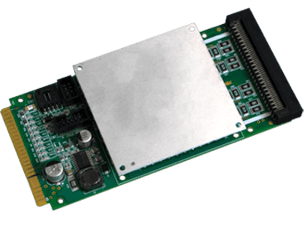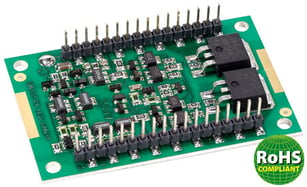Industrial Inkjet Printing
Delving into Industrial Inkjet Printing: Unveiling the Technologies, Techniques, and Applications Supported by Apex Microtechnology.
The Industrial printing industry has rapidly converted from traditional analog printing techniques like offset lithography and roto-gravure, to digital inkjet printing techniques such as continuous (CIJ) or drop-on-demand (DoD). The proliferation of inkjet technology is revolutionizing industrial printing by improving efficiency and minimizing waste while achieving new levels of print quality.
What is Industrial Inkjet Printing?
Industrial inkjet printing refers to the use of inkjet technology to print or deposit materials onto various surfaces, a process similar to your standard home or office inkjet printer. Industrial inkjet printers are not just limited to printing or marking, they can also be used to apply coatings, deposit precise amounts of functional materials, and even build micro or macro structures.
Inkjet technology ejects patterns of tiny drops onto various materials without physically making contact with the surface of the object. These patterns of dots are comprised of different colored inks which when combined, can create photo-quality images such as the one below.
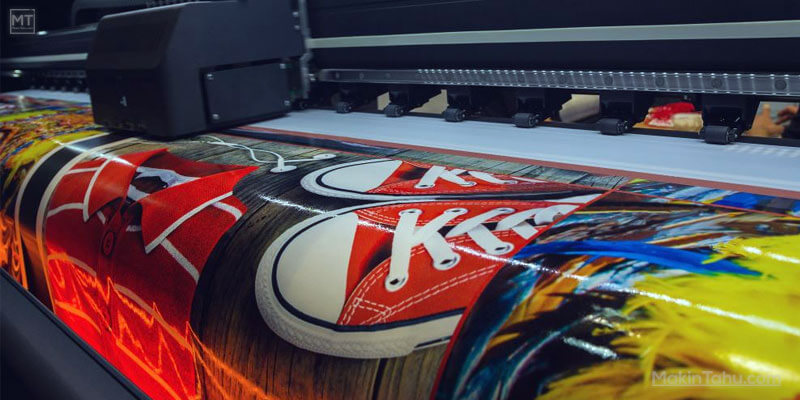
At first glance, this technique may appear fairly simple, but the design of these systems is incredibly complex. The systems are designed to achieve image resolutions up to 1440 dots per inch (DPI). The ejected dots are smaller than the diameter of a human hair with a diameter of 50 to 60 microns, requiring the systems to be built for extreme precision. The two primary inkjet technologies currently leading across the printing world are thermal bubble and piezoelectric.
Thermal Bubble Technology
Thermal bubble inkjet technology, also known as (TIJ), is a popular printing technology used in inkjet printers. It operates by utilizing resistors, which generate vapor bubbles within an ink-filled chamber. These bubbles, created by the heating elements, expel ink droplets through nozzles onto the printing surface, forming text, images, or graphics. The system typically consists of multiple ink chambers or channels, each connected to a tiny nozzle. Once the printing command is received, the printer sends electrical pulses to specific resistors based on the desired pattern or image. The resistors that receive the electrical pulse rapidly heat up causing the ink to vaporize and form small bubbles. The collapsing bubble creates a pressure wave that propels a tiny droplet of ink out of the nozzle and onto the printing surface. As these ink droplets are ejected by the nozzles, additional ink is replenished to the ink cartridge to ensure uninterrupted printing.
Thermal bubble inkjet technology provides high precision, accuracy, and color reproduction, making it suitable for applications in desktop printers, photo printers, label printers, and some industrial printing systems.
Piezoelectric Technology for Inkjet Printing
The second technique is based on piezoelectric technology, which uses the reverse piezoelectric effect to produce ink drops; under the influence of an electric field piezoelectric material deforms. This deformation is used to push ink out of a chamber, either by forcing a diaphragm down that forms part of the ink chamber, or by deformation of the walls of the ink chamber when these are made of piezoelectric material. Ejection of an ink drop also refills the ink chamber from the ink reservoir.
Unlike thermal bubble inkjet technology, that uses a current to heat a resistor, piezoelectric inkjet printing uses voltage to create an electric field in the piezoelectric material. The piezo is deformed, resulting in mechanical movement that pushes the ink out. Apex Microtechnology specializes in providing high power analog devices that meet the requirements of driving the dynamic and capacitive loads found in piezoelectric print systems.
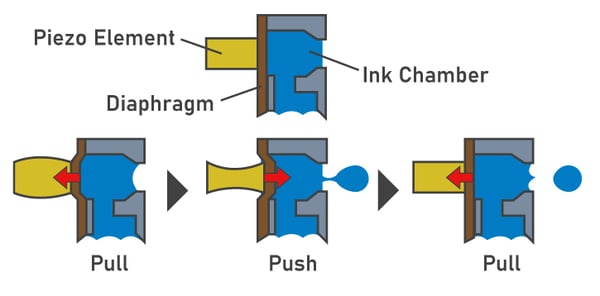
Types of Inkjet Methods Used in Industrial Printing
Furthermore, there are two primary classifications of industrial inkjet printing systems and their associated printheads: continuous (CIJ) and drop on demand (DoD), each with variations between them. Continuous inkjet technology operates by continuously ejecting droplets from the printhead, which are either used as printing drops or collected for recirculation and reuse. On the other hand, drop on demand technology only ejects droplets from the printhead when required.
Continuous Inkjet Printing (CIJ)
An efficient and dependable printing technique, Continuous Inkjet (CIJ) printing, operates by expelling electrically charged ink droplets from a printhead nozzle and propelling them through an electric field. CIJ printers utilize piezoelectric technology to break up the continuous inkjet stream into individual drops, which then fly through a charge tunnel where they are individually charged. After the drops are individually charged, they pass through a static electric field where they are deflected depending on their individual charge. Drops without charge are deflected into the gutter for reuse, while the charged drops land on the substrate depending on their charge and amount of deflection.
CIJ had traditionally been preferred over other inkjet technologies because it can use inks based on volatile solvents that dry quickly and improve adhesion on numerous substrates. However, the technology has several drawbacks, including moderately low print resolution, high maintenance requirements, and environmental risks because of its use of large volumes of volatile solvent-based fluids. Furthermore, the requirement that the printed fluid be electrically chargeable restricts the technique's applicability.
Drop on Demand Inkjet Printing (DoD)
Unlike continuous inkjet printing, drop on demand (DoD) only ejects ink drops from the printhead when and where it is required and exactly the amount of ink required to create the image. The quality of DoD print heads is unmatched, as they can achieve resolutions of 1440 DPI and gradients and greyscale effects at resolutions up to 1200 DPI. At a fraction of the material cost, drop on demand inkjet printers can match the throughput rates of a typical CIJ system while drastically reducing the waste output at the same time.
The advantages of DoD printers include:
- The systems can print directly over the surface of an item regardless of the surface.
- The systems improve cost by eliminating the need for package labels.
- Large character printing – DoD printers can print large size fonts and images that standard home or office printers cannot achieve.
- Compatible with special inks and colors for use on porous surfaces (paper, cardboard, wood) and impermeable surfaces (plastic, metal, glass)
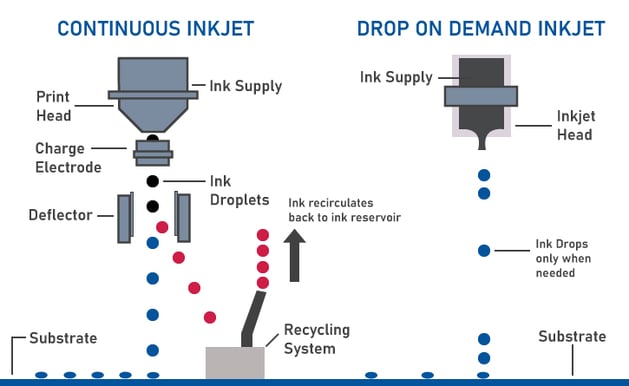
Regardless of the digital technology that is being used, these systems need adequate and equally complex power analog components to drive the dynamic or capacitive loads demanded by these printers. Apex Microtechnology offers power operational amplifiers specifically designed to drive CIJ and DoD inkjet printheads meeting the power requirements and boasting excellent waveform fidelity independent of the varying load capacitance for superior print quality. Below are a couple examples of Apex products proven across the industry to be exceptional solutions for the power analog challenges faced by the industrial inkjet print systems. For full Apex product selection by printhead visit our Inkjet Printing Application Page.
MM04 is an inkjet print head driver intended for use with the Ricoh GEN5 print head. The module contains an analog and a digital section. The analog section consists of four independent power amplifiers, each of which is capable of producing the fire pulses needed to drive up to 320 inkjet nozzles. The digital section uses 3-bit, digital printing data for selection of the printhead's nozzles to be fired and generates exactly timed analog input signals for the power op amps.
- Supports Ricoh GEN5 and Equivalent Print Heads
- UART or 12C Interfaces
- 4 Power-Analog Output Channels
- 4 Independent Waveform Generators
- Configurable Start-Up Mode
- Evaluation Tools with GUI Available
The MP108 is a 10 A, 200 V power operational amplifier that features a very high 300 kHz of power bandwidth for piezoelectric actuator and transducer drive applications. The MP108 has optional features such as four-wire current limit sensing and external compensation.
- High Power Bandwidth - 300 kHz
- High Voltage Operation - 200 V
- High Output Current - 10 A Continuous, 12 A Peak
- High power Dissipation - 100 W
- Available in Standard and A Grade Variants
For additional information about Apex products designed for inkjet printing applications, view the application notes below:
-Apex Microtechnology
